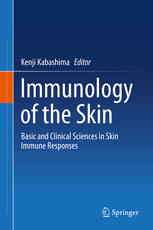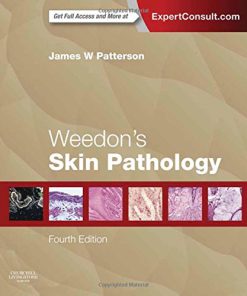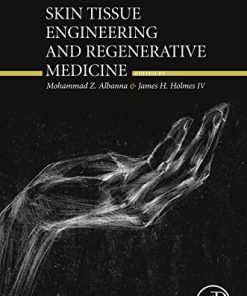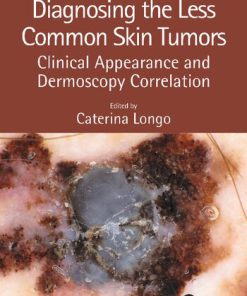Immunology of the Skin Basic and Clinical Sciences in Skin Immune Responses 1st Edition by Kenji Kabashima 4431558552 9784431558552
$50.00 Original price was: $50.00.$25.00Current price is: $25.00.
Immunology of the Skin Basic and Clinical Sciences in Skin Immune Responses 1st Edition by Kenji Kabashima – Ebook PDF Instant Download/DeliveryISBN: 4431558552, 9784431558552
Full download Immunology of the Skin Basic and Clinical Sciences in Skin Immune Responses 1st Edition after payment.

Product details:
ISBN-10 : 4431558552
ISBN-13 : 9784431558552
Author: Kenji Kabashima
This book reviews the role of each cell subset in the skin, providing the basics for understanding skin immunology and the mechanisms of skin diseases. The skin is one of the immune organs and is continually exposed to foreign antigens and external stimuli that must be monitored and characterized for possible elimination. Upon exposure to foreign antigens, the skin can elicit a variety of immune responses in harmony with skin components that include keratinocytes, dendritic cell subsets, mast cells, basophils, fibroblasts, macrophages, gamma-delta T cells, neutrophils, myeloid-derived suppressor cells, vascular and lymphatic cells, hair follicles, platelets, and adipose tissues, among others. In the past 10 years, knowledge of immunology has expanded drastically in areas such as innate immunity (Toll-like receptors, C-type lectins), and host defenses to bacteria and viruses, and this increased knowledge has led to the development of more effective treatment of psoriasis and other skin diseases. This book provides updates on the mechanisms of skin diseases including contact dermatitis, atopic dermatitis, psoriasis, urticaria, drug eruption, bullous diseases, anaphylaxis, graft-versus-host disease, rosacea, lymphoma, photodermatology, and collagen vascular diseases. Understanding the basics of skin immunology will help clinicians and dermatologists use new therapeutics such as biologics efficiently. Serving as an intermediary between basic science and clinical medicine, this book gives readers the opportunity to understand and marvel at the mystery and fascination of skin immunology.
Immunology of the Skin Basic and Clinical Sciences in Skin Immune Responses 1st Table of contents:
Chapter 1: Overview: Immunology of the Skin
1.1 Skin as an Immune Organ
1.2 Concept of SALT (Skin Associated Lymphoid Tissue)
1.3 Immune Reactions to Foreign Antigens
1.3.1 Immune Reactions to Haptens
1.3.2 Immune Reactions to Protein Antigens
1.4 Interplay Between Skin Barrier Functions and Skin Immunology
1.5 Communication Between the Skin and Draining LNs
References
Part I: Components of Skin Immune Cells
Chapter 2: Stratum Corneum
2.1 Introduction
2.2 Stratum Corneum Structure
2.2.1 Corneocyte
2.2.2 Cornified Envelope
2.2.3 Corneocyte Lipid Envelope
2.2.4 Lamellar Membrane Structure
2.3 pH in the Stratum Corneum
2.4 Barrier Function
2.4.1 Epidermal Permeability Barrier
2.4.2 Antimicrobial Barrier
2.4.3 Antioxidant Barrier
2.4.4 UV Barrier
2.5 Roles of Stratum Corneum in Immunity
2.5.1 Innate Immunity
2.5.1.1 Cathelicidin
2.5.1.2 Defensins
2.5.1.3 Other Epidermal Antimicrobial Peptides
2.5.2 Adaptive Immunity
2.6 Conclusion and Perspective
References
Chapter 3: Keratinocytes
3.1 Pathogen Recognition by Keratinocytes
3.2 AMPs
3.3 Allergy Triggered by Keratinocytes in Innate Immunity
3.3.1 Allergy Triggered by S. aureus
3.3.2 AD and House Dust Mite (HDM) Allergen
3.3.3 NLRP3 Inflammasome
3.3.4 Activation of the Keratinocyte Inflammasome by Group 1 HDM Allergens
3.3.5 Activation of Keratinocyte by Group 2, 3, and 9 HDM Allergens
3.4 Allergen Activation of Epithelial Cells
3.5 Protease Allergens and Epithelium
3.6 Eccrine Sweat and Allergy
3.7 Conclusion
References
Chapter 4: Langerhans Cells and Dermal Dendritic Cells
4.1 Introduction
4.2 Dendritic Cells (DCs) of the Skin
4.2.1 Langerhans Cells
4.2.1.1 Localization
4.2.1.2 Surface Marker
4.2.1.3 Homeostasis of LCs
4.2.2 Dermal Dendritic Cell
4.2.2.1 Components and Surface Markers of Dermal DCs
4.2.3 Plasmacytoid Dendritic Cells
4.2.4 Inflammatory Dendritic Cells (Tip-DCs and IDECs)
4.2.4.1 Tip-DCs
4.2.4.2 IDECs (Inflammatory Dendritic Epidermal Cells)
4.3 Roles of Cutaneous DCs in Skin Immune Responses
4.3.1 The Role of Each Cutaneous DCs Subset in the Murine CHS Model
4.3.2 The Role of Cutaneous DCs in Atopic Dermatitis (AD)
4.4 Concluding Remarks
References
Chapter 5: T Cells
5.1 Introduction
5.2 Characteristics of αbetaT Cells in the Skin
5.3 Generation of Skin-Homing T Cells
5.4 Subsets of αbetaT Cells
5.5 CD4 T Cells
5.5.1 Th1 Cells
5.5.1.1 Characteristics of Th1 Cells
5.5.1.2 Differentiation of Th1 Cells
5.5.2 Th2 Cells
5.5.2.1 Characteristics of Th2 Cells
5.5.2.2 Differentiation of Th2 Cells
5.5.2.3 Th2 Cells and Skin Pathology
5.5.3 Th17 Cells
5.5.3.1 Characterization of Th17 Cells
5.5.3.2 Differentiation and Activation of Th17 Cells
5.5.3.3 Metabolism and Other Factors Affecting Differentiation of Th17 Cells
5.5.3.4 Th17 (and Th22) Cells in Skin Diseases
5.5.4 Th22 Cells
5.5.4.1 Function of IL-22
5.5.4.2 Characterization of Th22 Cells
5.5.4.3 Differentiation of Th22 Cells
5.5.4.4 Th22 Cells in Skin Diseases
5.5.5 Th9 Cells
5.5.5.1 Function of IL-9
5.5.5.2 Differentiation of Th9 Cells
5.5.5.3 Role of Th9 Cells
5.5.6 Follicular Helper T (Tfh) Cells
5.5.7 Regulatory T (Treg) Cells
5.5.7.1 Foxp3+ Treg Cells
5.5.7.2 Characterization of Foxp3+ Treg Cells
5.5.7.3 Subsets of Treg Cells
5.5.7.4 Differentiation of tTreg Cells
5.5.7.5 Differentiation of pTreg Cells
5.5.7.6 Treg Cells in the Skin
5.5.7.7 Mechanism of Suppression
5.5.7.8 Evidence for Presence of Treg Cells That Do Not Express Foxp3
5.5.7.9 Tr1, Th3, and LAG3 Treg Cells
5.6 CD8 T Cells
5.6.1 Characterization of CD8 T Cells in the Skin
5.6.2 Tissue-Resident Memory T Cells in the Skin
5.6.3 CD8 T Cells and Skin Diseases
5.7 Innate-Like T Cells
5.8 Manipulation of T Cells to Treat Skin Inflammation and Cancer
5.9 Conclusion
References
Chapter 6: gammadelta T Cells
6.1 Introduction
6.2 Murine gammadelta T Cells
6.2.1 Murine gammadelta T-Cell Subsets and Their Development
6.2.2 DETCs
6.2.3 Murine Dermal gammadelta T Cells
6.3 Human gammadelta T Cells
6.3.1 Human gammadelta T-Cell Subsets
6.3.2 Human Vdelta1 T Cells
6.3.3 Human Vgamma9Vdelta2 T Cells
References
Chapter 7: B Cells
7.1 Introduction
7.2 B Cell Development
7.3 B Cell Subset
7.4 B Cell Activation
7.5 Antibodies
7.6 Cytokines
7.7 Regulatory B Cell
7.8 B Cell and Disease
7.9 Therapeutic Intervention of B Cells
7.9.1 Anti-CD20
7.9.2 Anti-CD22
7.9.3 Anti-BAFF
7.9.4 Anti-IgE
References
Chapter 8: Mast Cells and Basophils
8.1 Introduction
8.2 Characteristics of Mast Cells
8.3 Characteristics of Basophils
8.4 Mast Cell-Specific Depletion Model
8.5 Basophil-Specific Depletion Model
8.6 Mast Cell and/or Basophil Involvement in Several Skin Diseases
8.7 The Role of Mast Cells During Contact Hypersensitivity
8.8 The Role of Mast Cells During AD Pathogenesis
8.9 New Role of Basophils During Th2 Skewing
8.10 Basophil-Dependent Delayed Type Hypersensitivity
8.11 Conclusion
References
Chapter 9: Neutrophils
9.1 Introduction
9.2 Neutrophil Residence in Bone Marrow and Release into Circulation
9.3 Neutrophil Entry into the Skin and Interstitial Dermal Migration
9.4 Neutrophil Functions at the Site of Tissue Injury
9.4.1 Phagocytosis
9.4.2 Granule Composition and Release
9.4.3 Neutrophil Extracellular Traps (NETs)
9.5 Neutrophil Recirculation and Transport of Antigen
9.6 Neutrophil Apoptosis and Resolution of Inflammation
9.7 Neutrophil Deficiencies
9.8 Neutrophilic Dermatoses
9.9 Neutrophils During Cutaneous Infection: S. aureus as a Model Pathogen
9.10 Concluding Remarks
References
Chapter 10: Macrophages
10.1 Introduction
10.2 Functional Diversity of Macrophage Subsets
10.3 Macrophages in Wound Healing
10.4 Macrophages in Atopic Dermatitis
10.5 Perspectives
References
Chapter 11: Myeloid Derived Suppressor Cells
11.1 Introduction
11.2 Definition of MDSC
11.3 Expansion, Recruitment, and Differentiation of MDSCs
11.3.1 Tumor-Associated Inflammation
11.3.2 Angiogenetic Factor
11.3.3 Chemoattracttant Factors
11.4 Mechanisms of Suppressive Function of MDSC
11.5 Immunosupportive Therapy by Targeting MDSCs
11.5.1 Depletion of MDSCs
11.5.2 Differentiation of MDSCs into Immunogenic Macrophages
11.5.3 Inhibition of Recruitment of Macrophages to the Tumor Site
11.6 Concluding Remarks
References
Chapter 12: Lymphatic Vessels
12.1 Introduction: An Essential Role of Lymphatic Vessels in the Skin
12.2 Development of Cutaneous Lymphatic Vessels in Mice
12.3 Role of Tumor Lymphangiogenesis in Cancer Metastasis
12.4 Role of Lymph Node Lymphangiogenesis in Tumor Progression
12.5 Role of Lymphatic Vessels in Inflammatory Diseases
12.6 Perspective
References
Chapter 13: Hair Follicles
13.1 Introduction
13.2 Fundamental Knowledge of the Hair Follicle
13.2.1 Morphology and Microanatomy
13.2.2 The Bulge Area Provides the Stem Cell Niche
13.2.3 Hair Cycle and the Change in HF Structure
13.2.4 Dissimilarities Between Mouse and Human Hair Follicles
13.3 Immunological Features of Respective Hair Follicle Compartments
13.3.1 The Infundibulum~the Isthmus
13.3.2 The Bulge
13.3.3 The Suprabulbar Portion~the Bulb
13.4 Conclusion
References
Chapter 14: Platelets
14.1 Properties of Platelets
14.2 Immune-Associated Molecules in Platelets
14.2.1 Molecules in Platelet Granules
14.2.2 Surface Molecules Expressed on Platelets
14.2.2.1 P-Selectin
14.2.2.2 CD40 Ligand
14.2.2.3 Integrins
14.2.2.4 Chemokine Receptors
14.2.2.5 Toll-Like Receptors (TLRs)
14.2.2.6 High-Affinity Receptor for IgE (FcepsiRI)
14.2.3 Soluble Mediators in Platelets
14.2.3.1 Chemokines
14.2.3.2 Platelet-Derived Microparticles (PDMPs)
14.2.3.3 Antibacterial Proteins
14.2.3.4 Serotonin
14.3 Platelet Interactions with Leukocytes and the Endothelium
14.3.1 Interaction of Platelets with the Endothelium
14.3.2 Interaction of Platelets with Leukocytes
14.4 Role of Platelets in the Pathogenesis of Inflammatory Diseases and Conditions
14.4.1 Allergic Skin Diseases
14.4.1.1 Platelet Activation in Atopic Dermatitis
14.4.1.2 Role of Platelet P-Selectin in Allergic Skin Diseases
14.4.1.3 Role of Platelet-Derived Soluble Mediators in Allergic Skin Diseases
14.4.2 Bacterial Infection
14.4.3 Psoriasis
14.4.4 Regulation of Inflammatory Processes
References
Chapter 15: Adipose Tissues
15.1 Introduction
15.2 Obesity and Adipose Tissue Inflammation
15.2.1 Obesity and Pathophysiology of the Skin
15.2.2 Macrophage Accumulation in Adipose Tissues
15.2.3 Heterogeneity of ATMs
15.2.4 Adipocyte-Resident Tregs
15.3 Inflammatory Mediators from Adipose Tissues
15.3.1 Adiponectin
15.3.2 Leptin
15.3.3 Resistin
15.3.4 PAI-1
15.3.5 IL-6
15.3.6 TNF-α
15.4 Obesity and Psoriasis
15.4.1 Role of Obesity in Psoriasis Patients
15.4.2 Adipokines in Psoriasis Patients
15.5 Conclusions
References
Part II: Immune Systems in the Skin
Chapter 16: Innate Immunity
16.1 Introduction
16.2 Pattern Recognition Receptors
16.3 Toll-Like Receptors
16.4 NLRs and the Inflammasome
16.5 Other PRRs
16.6 Antimicrobial Peptides
16.7 Innate Immunity and Skin Diseases
16.8 Summary
References
Chapter 17: C-Type Lectin Receptors
17.1 Overview
17.2 Selected CLRs
17.2.1 Langerin (CD207, CLEC4K)
17.2.2 DC-SIGN (CD209, CLEC4L)
17.2.3 Dectin-1 (CLEC7A)
17.2.4 Dectin-2 (CLEC6A)
17.2.5 DCIR (CLEC4A) and DCAR (Clec4b)
17.2.6 BDCA-2 (CD303, CLEC4C)
17.2.7 Mincle (CLEC4E)
17.3 Concluding Remarks
References
Chapter 18: Emergence of Virulent Staphylococci Overriding Innate Immunity of Skin in Communities
18.1 Introduction
18.2 Emergence of CA-MRSA
18.3 Clinical Background of CA-MRSA Infection and Bacteriology
18.4 Genetic Diversity of CA-MRSA
18.5 Virulence Factors of CA-MRSA
18.5.1 Leukocidin
18.5.2 Cytolytic Peptides
18.5.3 Arginine Catabolic Mobile Element (ACME)
18.5.4 Attachment and Adherence to Host (Biofilm)
18.5.5 Protection from Antimicrobial Peptides
18.5.6 Escape from Phagocytes
18.5.7 Escape from Complement Activation and Chemotaxis
18.6 Conclusion
References
People also search for Immunology of the Skin Basic and Clinical Sciences in Skin Immune Responses 1st:
what is basic immunology
clinical scientist immunology jobs
immunology of the skin
immunology basics pdf
basic and clinical immunology
Tags: Immunology, the Skin Basic, Clinical Sciences, Skin Immune Responses, Kenji Kabashima
You may also like…
Medicine - Immunology
Basic Immunology and Its Clinical Application 2024th Edition Mitsuru Matsumoto












